
Developer: Subset games
Publisher: Subset games
Platform: PC, Mac, Linux
FTL: Faster Than Light – Review
Way back in April of last year, FTL was one of the first games to ever get funded on Kickstarter and also one of the first to actually make it to release. So is it proof that this whole Kickstarter, crowd-funding trend actually works? That it has the potential to give games that would otherwise probably never see the light of day a chance? Or is this little space sim game just the proof skeptics need to put a final bullet in the whole Kickstarter story?
Story:
FTL is the story of a Federation ship and its crew, on a secret mission to get an intercepted data package back to their headquarters. Throughout the entire game you are being chased by the Rebel fleet from which you intercepted the package from. You try to stay ahead of them going from sector to sector, helping strangers on the way. Now I will admit the story in FTL is not really the most important part of the game at all. It merely serves as a reason as to why you and your crew are flying through space doing what they do. The rebel fleet chasing you is merely to create a sense of urgency and tension and that really helps the game and its pace along.
Graphics:
The best way to describe FTL’s art style is a modern day version of old school bit style graphics. What I mean by that is the game has the style of one of those old games but they look like they’ve been made a lot smoother and better looking. The menu’s for example look a lot more pixelated while the ships have the same style but look all smooth and more modern. This makes for a very stylized and good looking game. Now we’ve been seeing a lot of this fake bit style of graphics in Indie games lately and that’s pretty understandable in a way. It’s a graphical style that is relatively easy and cheap to design your game with. For that reason, some people think it’s lazy to use this style. Now there might be games where that actually is the case but I can tell you FTL isn’t one of those. The graphical style of the game is part of the reason it is so cool and adds to the character it has.
Sound:
When it comes to the sound part of FTL there’s only one thing I can say and that this: I’m in love with the music of this game. The music is so good, so fitting, so catchy, it’s just an amazing soundtrack that fits the game so perfectly. It’s a nice piece of original music that really sounds futuristic, spacy and, surprisingly enough, creates a nice contrast at times. The soundtrack can be very relaxing even at times where the game is very tense and for some strange reason, it just works. The in-game sound then, now it might not be on the same level as the game’s music but it is still good none the less. Each little action, weapon fire, or mouse-click has a nice little sound that goes along with it and makes everything just a little bit more satisfying.
Gameplay:
On to the final part of this review then: how does it play? Now before I go on about how it plays I should probably elaborate a little more on what it is first. FTL is a space combat and exploration rouge-like with RPG elements. Now what that means is you basically fly from one point on the map to another, trying to make your way through a sector, basically a sort of dungeon, with random encounters and events at each point. In these you earn scrap, new crewmembers and sometimes if you’re really lucky you get a new weapon or enhancement for your ship. You can use your scrap to upgrade your ship getting more power or upgrading one of your systems. The other way you can spend your scrap is in the stores you come across. Here you can repair your ship, buy fuel or ammo for your projectile based weapons, or buy new weapons, augmentations or crewmembers. Each ship has 4 weapon slots in which you can put basically any weapon you want, but you’ll need to get enough power and upgrades in your weapon system to use them all at the same time.
The combat system is a fairly simple one. Your ship has a hull and shields, your shield regenerates over time and your hull needs to be repaired at a shop or by drones. You fight by selecting a weapon that’s charged and clicking on the part of the enemy ship to fire at. Ships are divided into rooms and each room is a spot you can target to fire. Each weapon has its specific recharge time, some are better at penetrating shields, some cause fire and some do extra damage to the enemies hull. You win a fight by killing all of a ship’s crew or destroying a ship, which requires you to destroy its hull: basically bring the health bar to zero. You can choose auto-fire mode, which fires weapons automatically once they’re charged and you’ve selected a target, that target will stay selected until you change it. You can also chose manual fire mode, where you have to fire a weapon yourself each time it’s charged but this can sometimes help if you have to swap between targets fast.
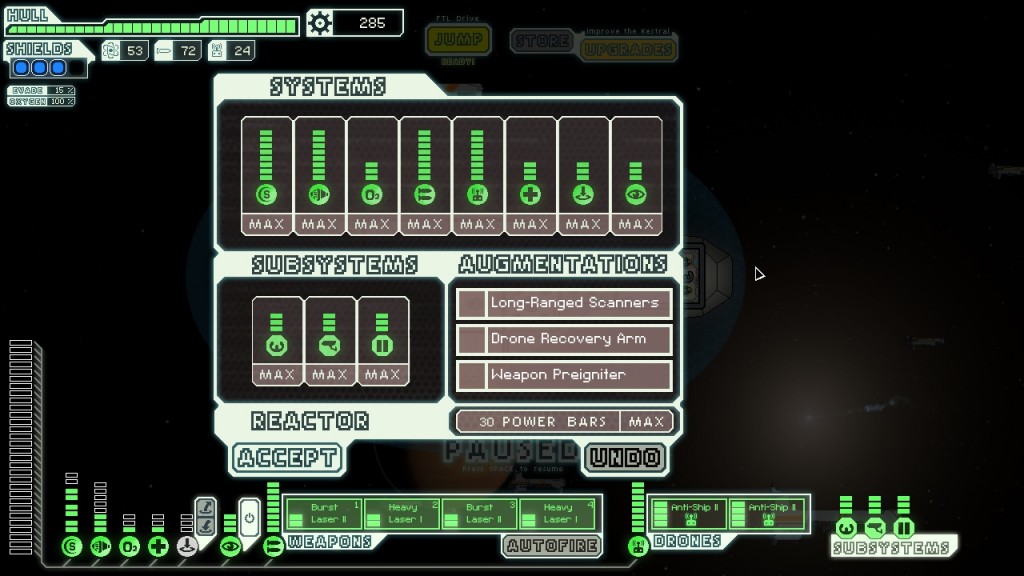
Now FTL is a game that can theoretically be completed in under 2 hours, but you’re going to have to be lucky to be able to finish it at all. The reason for that is that the game is incredibly hard, to the point where I still haven’t been able to beat the final boss after getting to him several times,(you have to start over once you die, the rogue-like element of the game) I don’t even make it to the last sector half of the time. The game has two difficulty modes, easy and normal, but don’t let those names fool you. Now easy is easier than normal that’s true, but easy can still kick your ass before you get even halfway through the game if you’re unlucky. Don’t get me wrong here it’s not like the game is pure luck based, you do get better at the game over time and it helps. But like in every RPG you can get lucky with stuff like loot and random encounters to make your game a whole lot easier.
As if that isn’t enough the game has 8 extra ships you can unlock, each different from the other when it comes to all the starting gear you get. On top of that though each ship has a second lay-out or version you can unlock by completing two achievements with the first version Again these second versions are varied enough from the first one’s that they change up the game and how you’ll play making for some great extended life for this game.
Conclusion
So, Kickstarter success or not? I’d say great success if you ask me. FTL is an amazing little indie game and to me the type of game that makes me believe that indie developers really are the future of this industry. And if Kickstarter is a tool to give developers who otherwise wouldn’t get a chance a platform to get their game made, I fully support that. FTL is an excellent game with excellent gameplay. Most of all it really shows how you can make a game go from one you can, in theory, complete in a of couple hours, to one you can sink several dozen hours into. Some of them are going to be frustrating, but most of them are going to be a lot of fun.
I’m really glad I finally got to review one of my Top ten games of 2012 and for as cheap as it is, I don’t see a reason you shouldn’t go buy it right now.

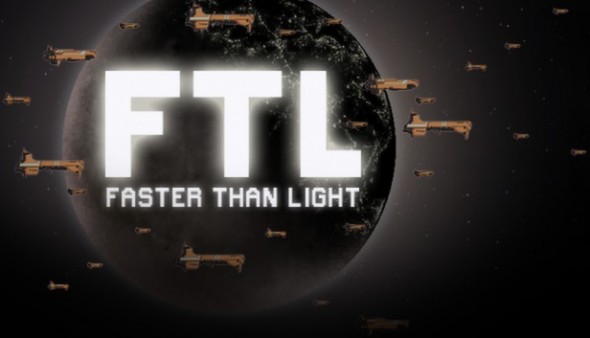
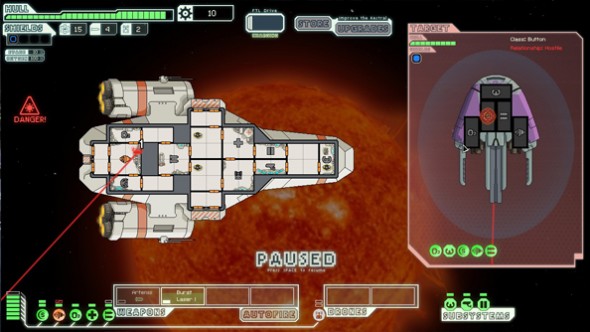
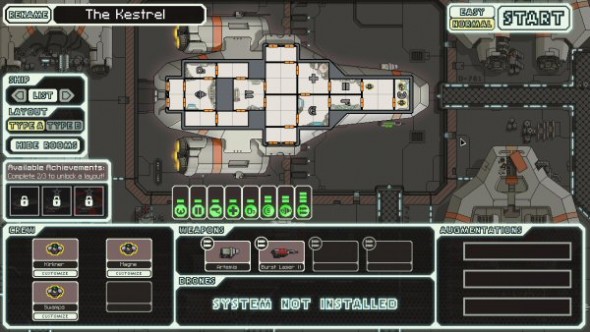
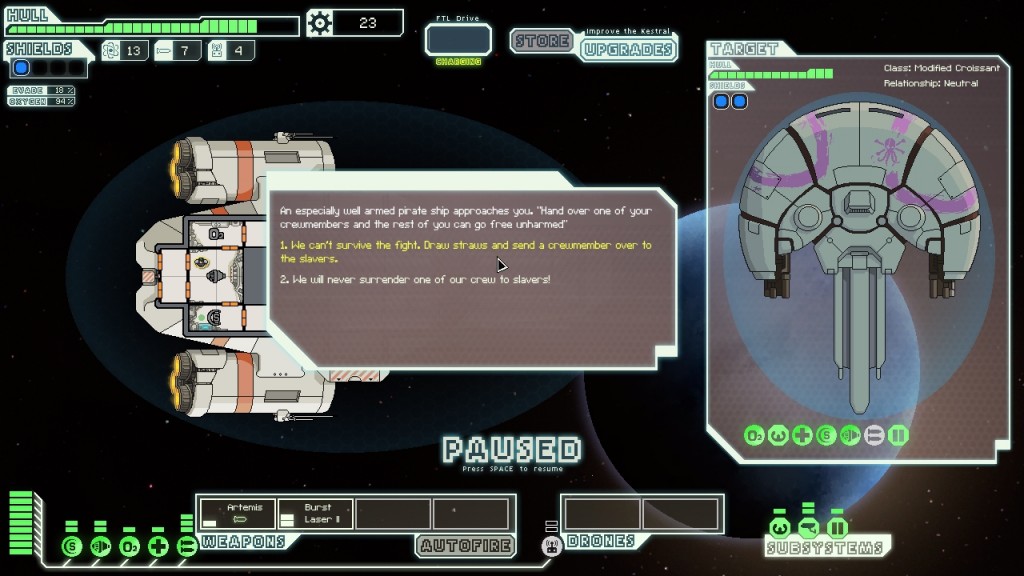

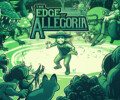


No Comments